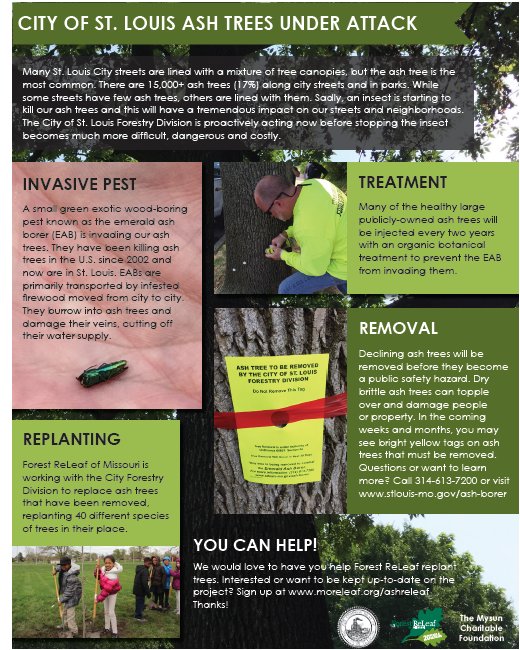AgEBB-MU CAFNR Extension
Green Horizons
Volume 20, Number 3
September 2016
Urban Forestry
Fighting Emerald Ash Borer in St. Louis
By Tom Ebeling | Community Forester, Forest ReLeaf of Missouri
The City of St. Louis began preparing for an Emerald Ash Borer (EAB) infestation in 2008, when the pest was first discovered in the state of Missouri. The first step that the city took was to update the tree inventory. The study revealed that there are approximately 15,000 Ash trees along the streets and in the parks of St. Louis. At 17% of the total trees maintained by the city, Ash is the most common species along city right-of-ways. The city has not planted any species of Ash since 2008, and prioritized the removal of Ash trees that were known to be in poor condition. Despite best efforts, Ameren utility workers discovered EAB in St. Louis on May 16, 2015.

Since that time, the City has enacted a 5-year action plan that includes removal, retention and replanting with a goal of zero net canopy loss. In May of this year, contractors began removals in ward 1, which is the area surrounding the original infestation. Crews will work to remove about 2,600 trees every year for the next five years.
The City of St. Louis does not intend, however, to remove every ash tree in the city. Those ash trees that are 13 inches DBH (Diameter at Breast Height) or greater and in good condition will be treated by injecting the trunks with a botanical pesticide. The chemical is called TreeAzin and is produced by BioForest Technologies, Inc., in Canada. The active ingredient in TreeAzin is azadirachtin, which is extracted from neem tree seeds. Because it is a botanical compound, TreeAzin will degrade quickly in soil and runoff, minimizing the environmental impact. The compound is also safe to inject in high use public areas. Because all untreated ash trees will die, TreeAzin must be injected every two years to ensure the survival of the tree. In total, St. Louis will retain about 1,200 ash trees that are seen as too valuable to remove (about 7% of the current ash population).
In order to replant the voids created by the extensive removal operation, the City of St. Louis will be partnering with Forest ReLeaf of Missouri (FRM), a nonprofit nursery that grows native species of trees and shrubs for planting in public spaces. Forest ReLeaf will donate a variety of 15-gallon trees, as well as help coordinate the planting of those trees. The trees will be selected from a list of approximately 40 native species that are tolerant of urban conditions and suitable for streettree plantings. Ideally, every ash tree that is removed will have a new acceptable native planted in its place, resulting in a zero net loss of canopy. Forest ReLeaf will plant 1,200 trees in ward 1 alone by the end of this year. With help from the City Forestry Division, community organizers, elected officials and countless volunteers, FRM will work throughout St. Louis to reforest areas devastated by EAB.
Forest ReLeaf is also conducting an extensive public relations campaign to educate the members of the communities most affected by the removal of ash trees. In many neighborhoods throughout St. Louis, most or all of the mature trees will be lost to this pest. It is important that the residents understand what has happened to the trees and what is being done to recover the loss. FRM is accomplishing this by exhibiting at community events, distributing informational flyers, reaching out to known neighborhood organizers, and educating the young people of the City. Because FRM has access to elementary and middle school audiences through its' educational programs, its' goal is to inform the children of these neighborhoods in the hopes that they will carry the information back to their parents and grandparents and subsequently get involved in the planting efforts. These outreach methods will help ensure that individuals are wellinformed about the ongoing battle to maintain our urban forest in St. Louis.
To Read the City's action plan, please visit www.stlouis-mo.gov/ash-borer
Information on Forest ReLeaf 's ash tree replanting efforts can be found at www.moreleaf.org/ashborer
